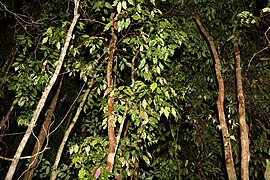Syzygium unipunctatum
| Rolypoly satinash | |
|---|---|

| |
| Scientific classification | |
| Kingdom: | Plantae |
| Clade: | Tracheophytes |
| Clade: | Angiosperms |
| Clade: | Eudicots |
| Clade: | Rosids |
| Order: | Myrtales |
| Family: | Myrtaceae |
| Genus: | Syzygium |
| Species: | S. unipunctatum
|
| Binomial name | |
| Syzygium unipunctatum | |
| Synonyms[3] | |
| |

Syzygium unipunctatum, commonly known as the rolypoly satinash, is a small tree in the family Myrtaceae. It is endemic to the rainforests of the Wet Tropics of Queensland.
Description[edit]
Syzygium unipunctatum is a small evergreen tree growing up to about 20 m (66 ft) tall.[5][6] The leaves are elliptic to ovate and are arranged in opposite pairs on the twigs. New growth is pink or red while mature leaves are glossy green. The leaves have wavy edges and they measure up to 12 cm (4.7 in) long by 5 cm (2.0 in) wide.[5][7][8] Intramarginal veins (i.e. veins that parallel, and are close to, the leaf margins or edges) are present, about 2 mm (0.08 in) from the margin; the secondary veins are numerous and straight; tertiary venation is reticulate.[5]
The inflorescence is a panicle produced either terminally or from the leaf axils,[5][6][7] and the white/cream flowers are small with 4 or 5 petals.[5][8] The fruit is a pink, blue or purple berry measuring up to 12 mm (0.47 in) long by 15 mm (0.59 in) wide.[5][6][7] It has a number of longitudinal grooves on the surface, giving it the appearance of a miniature pumpkin.[7]
Taxonomy[edit]
In 1983 the noted Australian botanist Bernard (Bernie) Hyland published a review of the genus Syzygium, in which he created a new genus – Waterhousea – to accommodate four new taxa, one of them being W. unipunctata. Hyland's description of this new species was based on plant material collected by V.K. Moriaty near Mossman in 1945.[9] His paper was titled "A Revision of Syzygium and Allied Genera (Myrtaceae) in Australia," and was published in the Australian Journal of Botany in 1983.[10]
Just over 20 years later, in 2006, another major review of Syzygium and closely related genera was published by Lyndley Craven, Edward Sturt Biffin and Peter Shaw Ashton, with the result that Waterhousea was transferred to Syzygium (along with Acmena, Acmenosperma, Cleistocalyx and Piliocalyx), and this taxon was given the new combination Syzygium unipunctatum.[4]
Etymology[edit]
The genus name Syzygium comes from the Ancient Greek sýzygos, meaning 'joined', 'yoked', or 'paired', and refers to the paired leaves. The species epithet unipunctatum is derived from the Latin words unus, meaning 'one' or 'single', and punctum, meaning 'spot' or 'dot', a reference to the fact that there is usually only one oil dot within each reticulation of the tertiary veins.[5][6]
Distribution and habitat[edit]
The range of Syzygium punctatum is restricted to coastal northeast Queensland from near Cooktown south to about Townsville. It grows as an understory tree in rainforest on a variety of soil types, and is widespread within the range. The altitudinal range is from sea level to about 1,200 m (3,900 ft).[5][7][11]
Conservation[edit]
This species is listed by the Queensland Department of Environment and Science as least concern.[1] As of 5 December 2023[update], it has not been assessed by the IUCN.
Cultivation and uses[edit]
The rolypoly satinash is becoming popular as a cultivated plant due to its colourful flushes of new growth and its unusual fruit. It does not grow large enough to produce useful timber.[7]
Gallery[edit]
-
Trunk
-
Habit
-
Foliage
References[edit]
- ^ a b "Species profile—Syzygium unipunctatum". Queensland Department of Environment and Science. Queensland Government. 2022. Retrieved 18 October 2022.
- ^ "Syzygium unipunctatum". Australian Plant Name Index (APNI). Centre for Australian National Biodiversity Research, Australian Government. Retrieved 5 December 2023.
- ^ a b "Syzygium unipunctatum". Plants of the World Online. Royal Botanic Gardens, Kew. Retrieved 18 October 2022.
- ^ a b Craven, L.A.; Biffin, E.; Ashton, P.S. (2006). "Acmena, Acmenosperma, Cleistocalyx, Piliocalyx and Waterhousea formally transferred to Syzygium (Myrtaceae)". Blumea. 51 (1): 139. doi:10.3767/000651906X622382. Retrieved 20 October 2022.
- ^ a b c d e f g h Craven, L.A.; Matarczyk, J.A. (2022). Kodela, P.G. (ed.). "Waterhousea unipunctata B.Hyland". Flora of Australia. Australian Biological Resources Study, Department of Climate Change, Energy, the Environment and Water: Canberra. Retrieved 5 December 2023.
- ^ a b c d Cooper, Wendy; Cooper, William T. (June 2004). Fruits of the Australian Tropical Rainforest. Clifton Hill, Victoria, Australia: Nokomis Editions. p. 372. ISBN 978-0958174213.
- ^ a b c d e f F.A.Zich; B.P.M.Hyland; T.Whiffen; R.A.Kerrigan (2020). "Syzygium unipunctatum". Australian Tropical Rainforest Plants Edition 8 (RFK8). Centre for Australian National Biodiversity Research (CANBR), Australian Government. Retrieved 18 October 2022.
- ^ a b "Syzygium unipunctatum". Australian Native Plants Society (Australia). Retrieved 21 October 2022.
- ^ "Waterhousea unipunctata". Australian Plant Name Index (APNI). Centre for Australian National Biodiversity Research, Australian Government. Retrieved 5 December 2023.
- ^ Hyland, B.P.M. (1983). "A Revision of Syzygium and Allied Genera (Myrtaceae) in Australia". Australian Journal of Botany Supplementary Series. 13 (9): 1–164. doi:10.1071/BT8309001. S2CID 89485920. Retrieved 5 December 2023.
- ^ "Search: species: Syzygium unipunctatum | Occurrence records". Australasian Virtual Herbarium. Australian Government. Retrieved 5 December 2023.
External links[edit]
 Data related to Syzygium unipunctatum at Wikispecies
Data related to Syzygium unipunctatum at Wikispecies Media related to Syzygium unipunctatum at Wikimedia Commons
Media related to Syzygium unipunctatum at Wikimedia Commons- View a map of recorded sightings of this species at the Australasian Virtual Herbarium
- View observations of this species on iNaturalist
- See images of this species on Flickriver



